Quilt Along #13 – Finishing a Quilt
Today is Quilt Along #13 and time to finish our little Heart and Feather Wholecloth once and for all!
I don’t know about you, but I’ve loved quilting this project along with all of you, seeing loads of photos on Facebook and Flickr, and watching your progress through this project.
So now it’s time to finish off this little quilt by soaking, blocking, and binding it. Let’s see a demonstration of each step in this video:
Now even though I covered almost everything in the video, I had to leave out loads of minor details that are very important so make sure to read through this article as well!
Important tip: Before you soak your quilt, remember back to the way you marked it. If you marked your quilt with a pencil or chalk, make sure to erase all the marks first.
Next measure from the edges of the feather motifs to the edges on the opposite side (right through the middle of the quilt) and record both the horizontal and vertical measurement on a piece of paper.

Now soak your quilt in warm water to rinse any remaining marks, starch, or other chemicals from the quilt. Let it set for around 15 – 30 minutes.
Throw the quilt in the dryer and let it tumble for a bit on low. Take the quilt out when it’s still damp, but not dripping wet.
Now it’s entirely up to you if you want to bother with blocking your quilt or not. I prefer to block all wholecloth quilts and wall hangings simply because they finish perfectly flat and hang beautifully after this process.
In the video I demonstrated blocking using 1 inch elastic strips to stretch the quilt over a small folding table. With larger quilts, I use my design wall, which is 2 inch thick styrofoam insulation boards. You can watch this blocking process in the video on the duchess right here.
Once the quilt is secured, measure the horizontal and vertical distance between the motifs that you recorded before soaking. If the quilt still isn’t quite to size, try stretching and pulling on one side at a time until the quilt is returned to the correct size.
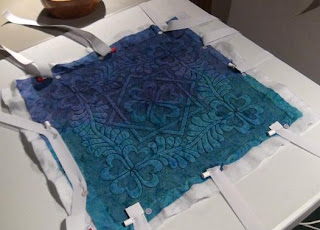
After all the sides are secured and the correct measurement reached, set up fans and allow your quilt to dry overnight.
Now it’s time to cut the edges down for binding and to square up this quilt. Of course, if you filled a wide area around your quilt, you can square this quilt to whatever size you’d like.
In the video, I first trimmed the edges with the 1 inch mark on my ruler lined up with the edges of the corner heart motifs. After trimming this down, I noticed the quilt wasn’t truly square and I trimmed another 1/4 inch off all sides.
It’s better to cut in smaller amounts than whack the quilt down massively. Had I cut the quilt immediately down to 3/4″ away from the motifs, I would have ended up having to trim down even more, and it’s very easy to start trimming and get closer and closer to those motifs, which doesn’t look good once the binding is applied.
Take your time with cutting and make sure to measure twice, cut once!
Now for the binding. This is a small quilt so the binding process won’t take a ton of time, but it’s definitely a step that can make or break this quilt so let’s work through this step by step.
First off, this is a densely quilted quilt so the edges will be quite compacted. I prefer to cut narrower 2 inch straight grain binding for this type of quilt.
If you prefer to work with a wider binding, you can easily cut your strips 2 1/4 or 2 1/2 inches wide. Go with whatever measurement you’re most used to.
You may need to seam multiple strips together in order to create a strip long enough to bind the entire quilt. Personally I prefer to seam binding pieces together with a diagonal seam like you can see in this photo:
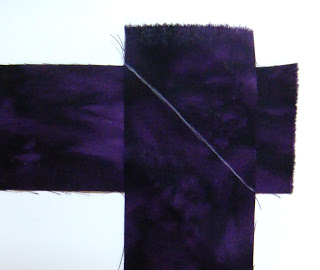
Once the binding is long enough to cover the entire quilt, plus about 10 inches extra, fold the entire strip in half and press. You might even want to starch this fold so it’s perfectly flat and stiff, which will make it easier to work with.
To bind this quilt entirely by machine, make sure to flip the quilt over and stitch the binding on with the BACK of the quilt facing up. This will allow you to secure the folded edge of the binding from the front later, which will create a nicer finish.
Now find the place where two binding strips were connected together. This thicker seam can be tricky to deal with if it falls in a corner, so place this seam area in the middle of the edge of the quilt. Gently smooth out the rest of the binding over the quilt, turning the corners, until you find the edge the binding will start and end.
For this quilt, I started stitching about 3 inches from a corner. Place a pin here to mark where the binding starts. It’s really not a good idea to pin all your binding in place as it can shift as you quilt.
Take the quilt to your machine and start stitching. It’s always a good idea to secure every start and stop when binding so take a few stitches forward, then a few stitches back, then stitch forward as usual with an accurate 1/4″ seam allowance.
When you get close to a corner, fold the binding up and make a crease to mark the exact edge of the quilt. Next, measure up from this crease (or the edge of the quilt) exactly 1/4 inch and place a pin on this spot to mark it.

Stitch to the pin. Do not stitch past it!
Backstitch to lock your stitches in place, then break your thread and remove the quilt from the machine.
Now comes the fun part of this process: the folding! Hold the quilt up in front of you with the binding extending to the right as it was stitched onto the quilt:
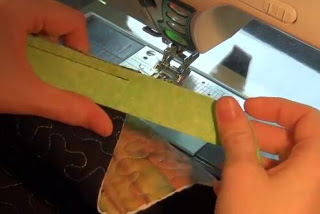
Now fold the binding straight up, creating a 45 degree angle running from the corner of the quilt to the edge of the binding. Finger press this fold in place.
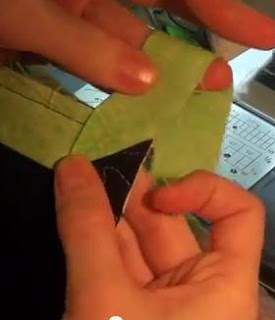
Now fold the binding straight down, matching up the raw edges of the binding with the raw edges of the quilt. Finger press again and place a new pin exactly 1/4″ from the top edge of the quilt. A helpful guide for this pin will be your previous stitching line.
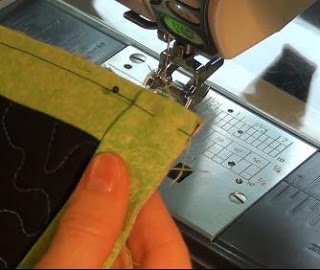
tNow place the quilt back into the machine and start stitching right at that pin. Backstitch to secure, then stitch the rest of the seam to the next corner.
Repeat these steps with each corner. When you turn the last corner, only stitch into the quilt 3 inches or so, then backstitch and break your thread.
Remove the quilt from your machine and spread it out on a table. Try to match up how your quilt looks with this photo:
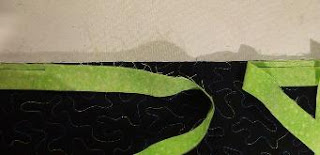
Spread out the left binding end over the edge of the quilt. You want to make sure this binding piece is perfectly smooth and flat to the edge of the quilt. No wrinkles or looseness allowed!
Place a pin in the middle of this area, inserting the pin in the fold of the binding. You’re not actually pinning the binding TO anything, you’re just marking a point on the binding.
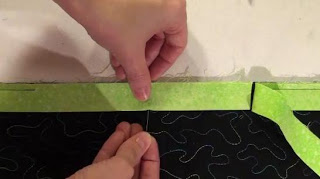
Now spread the right binding on top, spreading and smoothing it out exactly the same way. The two pieces of binding should be on top of one another, perfectly flat. Place another pin into the right binding, right on top of the pin in the left binding. The two pins should be right on top of one another.
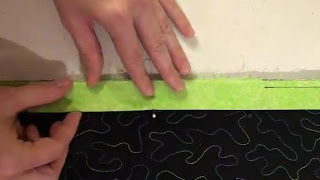
Now unfold the binding and place the LEFT binding on the table with the FOLD SIDE UP
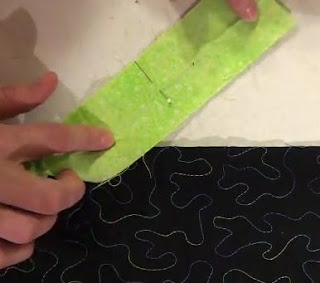
Unfold the RIGHT binding and place it FOLD SIDE DOWN.
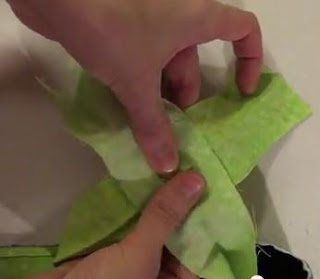
Line up the place where both pins entered the FOLD in the binding. These are the center points of where these two strips line up. The two binding strips should form a + shape with the left strip on the bottom and the right strip on top.
Pin this, and if you like, mark a line from left to right which will guide your stitching line through this binding strip.
Sew this seam, making sure everything stays nice and even through your machine. Unfold the quilt and the binding and double check it against your quilt.
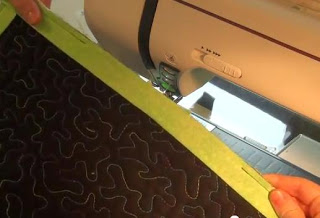
If things seem weirdly twisted, rip out this seam and stitch it again. Do not trim the tails of the binding until you’re 100% sure the binding is correctly stitched!
Trim the extra binding tails and finger press the seam open. Refold the binding to match with the other binding and smooth everything flat on the edge of the quilt.
The two ends of binding should fit together perfectly against the edge of the quilt. Place the quilt back into the machine and stitch this last bit of binding down, stitching from where you stopped stitching to where you originally started.
With this seam finished, this first part of binding is complete!
Now it’s time to finish the folded edge of the binding. You can do this part either by hand or by machine.
Personally, if a quilt is destined for a show or a special gift, I will always hand bind it. I just haven’t found a way to machine stitch binding so it’s 100% perfect on the front AND the back. It usually looks great on the front, but the back side will wiggle on and off the edge of the binding, which doesn’t look great.
So just keep that in mind as you learn this technique. It’s definitely much faster than hand binding, but it’s not as perfect.
The first step to binding (either hand or machine) is to fold your corners and press the binding over and around to the edges of the quilt.
To fold the corners, carefully tuck the extra little bit of fabric in this area to one side, then push the quilt into the little pocket created by this fold.
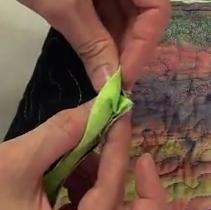
You’ll know you’ve done this right if you see this pretty little miter show up on the back of the quilt.
Now take your quilt to your ironing board and carefully press the binding over the stitching line. This makes it much more willing to fold over and around the edges of the quilt smoothly and evenly.
Flip the quilt to the front side, and starting in the middle of one edge, start folding the binding over to hit the original stitching line, and pin it in place
Work from the middle to the corners on all sides of the quilt. If you choose to hand bind, you don’t need to do this step. For machine binding, it’s far better to secure the binding with tons of pins so it doesn’t get all wobbly and out of control on the machine.
And when I say “tons” I mean TONS!
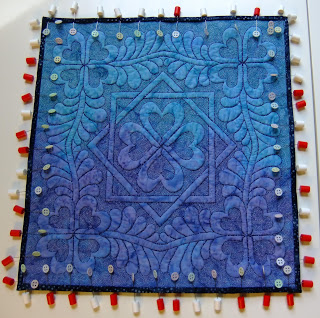
When machine binding you really need this many pins to keep the fold securely locked in place. This is the first time I used pinmoors to lock the ends of all these pins, which really reduced the number of times I got poked and scratched while binding this little quilt!
For the corners, pin up to this area on one side, allowing the fabric to fold over through the corner area. It will naturally form a triangular shape up through the other side of binding. Carefully fold the opposite side down, tucking that little bit of fabric up into the corner to make a miter on the front.
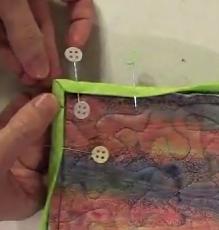
Pin this securely in place. You might even want to do a few hand stitches through the miter and the corner of the binding just to ensure it doesn’t come unfolded on the machine. It’s quite tricky to keep all of this perfect when you get a big walking foot over it, so it’s definitely advisable to hand stitch, glue, or pin it as securely as possible before stitching.
Once your binding is folded over and the corners are sorted, it’s time to stitch this side of the binding down by machine!
To do this, you really don’t need a fancy machine with a million decorative stitches. A simple zigzag stitch looks just fine and can easily do the job.
However if you have access to decorative stitches, a blanket stitch always produces a beautiful finish:
And if you want to get experimental, there’s really no limit to what stitch you use to secure the binding.
The most important key is to make sure that the machine hits the binding on the RIGHT swing of the needle, and stitches OFF the binding (through only the quilt) with the LEFT swing of the needle.
This ensures the binding is securely attached to the edge of the quilt and will look the best from the front.
You’ll need to make sure the decorative stitch you use is simple enough that it will evenly feed through your machine and not get garbled. Always remember you’re sewing through many layers when the machine stitches through the binding side, but only the layers of the quilt when it swings into the quilt side, and this can wreck havoc with complex designs.
Here’s a few good choices for binding designs:
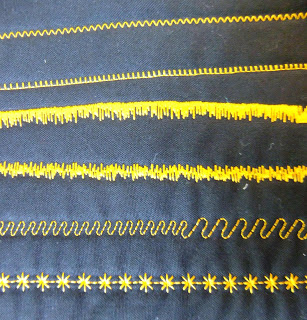
From the top:
Zigzag stitch – length 1.5, width 2.2
Blanket stitch – Janome Horizon #45 – length 2.2, width 2.2
Jagged satin stitch – Horizon #53 – standard settings
2nd jagged satin stitch – Horizon #54 – standard settings
Wiggle stitch – Horizon #100 – length 1.5, width 5.0
Star – Horizon #103 – length 1.5, width 5.0
It’s a good idea to stitch out your decorative stitches on a small scrap sandwich first so you can get a good idea of what the design will look like when it’s on your quilt. If you need to resize the design, narrow it, etc, make sure to record these settings on a piece of paper so if you turn off your machine and go back to binding later, you’ll be able to create the same stitch easily.
When it comes to corners, this area can get tricky. The best way to deal with them is to try to turn the corner with a design. Many machines have an “end of design” button that you can hit so the machine knows to stitch to the end of that motif and then stop.
If you do end up breaking thread in a corner, just double and triple check that your miters are staying folded and the binding isn’t wiggling off the line where it’s supposed to be. It’s really easy for the binding to do funky things in the corners:
Once all the stitching is finished, hide your threads inside the binding. If you want, you can also hand stitch the miters in each corner just to ensure they’re 100% secure.
So that’s it! This little Heart and Feather Wholecloth has been soaked, blocked, and bound!
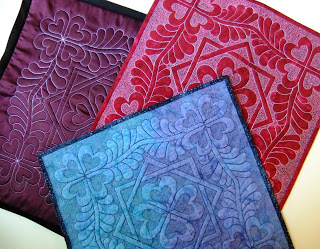
Of course, if you want to hang this wholecloth, you’ll also need to attach a hanging sleeve and you’ll probably also want a tag for the back with your name on it. Both of these steps are necessary, but I didn’t have time to fit them into this video, so they’ll be tutorials for another day.
Now it’s time to link up your progress and ask any questions that you have about Microstippling or free motion quilting in general!
Instructions for Linking Up Your Blog:
1. Write your blog post. Publish it on your blog.
2. Copy the link of the specific blog post. This is not just the link to your blog itself (www.freemotionquilting.blogspot.com), but the link to the specific post: https://freemotionproject.com/2012/01/quilt-along-2-quilting-in-rows.html
3. Click the blue link up button above and paste your link into the box.
Keep in mind that you’re posting your progress from LAST week on THIS week’s post. This way you have time to watch the lesson, play with the ideas, then post your progress to the next quilt along. I hope that makes sense!
As always, any questions you have, please post them in the comments below or on your blog and I’ll answer 5 tomorrow on Question Thursday.
Time for me to shut up and quilt,
Leah Day

Great video, I can hardly wait to get started!
It did make me think of a question: If I cut through the areas that are microstippled to square up my quilt, will this make the stitching more likely to come apart? Is it best to cut outside the quilted area?
Great question MC!
To square the quilt, you will most likely have to cut through your stippling.
No, this shouldn't make your stitching come apart. Microstippling is a dense design and isn't likely to come unraveled. I've left sliced quilts (lots of threads cut) unbound and the stitching hasn't come out.
Keep in mind that you're cutting the quilt down and immediately binding it, which will send a line of stitching right over the stippling, locking it in place. If you're concerned about stitches coming out, just cut and bind all in one day!
Cheers,
Leah
Beautiful, Leah. Thank you for sharing 🙂
Best,
Jae
Fantastic pictures and video as always! Now I can't wait to bind it. I have a quick question (you can save for Thursday if you want).
What's the best way to pull up the bobbin thread for tying off once you are done with a segment of quilting? I get how to do it in the beginning but the end was a little harder for me.
Christaquilts – Usually you should be able to tug lightly on the top thread and the bobbin thread will pop to the front as a loop. Use a needle to pull the loop through so the bobbin thread is on the front of the quilt, then tie a knot and hide the threads in the quilt.
If you find a particular set of threads stubborn, try pulling them to the back. If that doesn't work, hide each separately.
I hope that helps!
Leah Day
Great, thanks!
–Christa
Hi Leah. I just wanted to say that I am loving being a part of this little quilt community you have created. I really look forward to linking up on wednesdays and checking out our next set of instructions from you. And then, Thursday is like bonus, when you answer all of our questions! I always look at each blog linked up. I'm learning so much from everybody. I always wanted to make quilts ever since I can remember. When my oldest son (16) started school, I used to faithfully watch Simply Quilts after he was on the bus. i didn't have the time, tools or resources to get in to it. No internet back then to help me. I did make a few hand-tied quilts. But when I discovered your youtube videos about a year ago i watched and learned. You have sent me full- throttel into quilting!!! HUGE THANKS, for giving me the confidence and tools to do what I have always wanted!!! Just thought you should know, I mean, you ARE my teacher:)
The microstippling was easier than I thought it would be. I have a hard time controlling very small designs- but this was so simple I actually ended up not using my foot pedal and just using the start/stop button and moving the quilt. I didn't have to speed up and slow down around the curves like I normally do on large designs.
It does take FOREVER. I can't imagine doing a bed size quilt (though I love the look…) but I'm really glad I did this!
I need to do about another inch around the design so I have enough to cut into without getting too close, but I'm about to go on vacation so I'll be behind for binding and miss linking up that one!
I hope you do another one of these quilt alongs!
I just discovered this blog and am so impressed with your attitude of teaching us your wonderful techniques. Thank you.
Oh, and BTW, I love that little two-tone blue quilt. Did you dye it to get those blues?
Hi Leah,
I didn't use a chemical starch,instead used homemade starch from rice. And its very light and used a frixon pen for marking. The markings are gone using the heat application. So, my questions is do I still need to soak and box the quilt as shown in the video if this is going to be a wall hanging.
I'm a novice when it comes to quilting, forgive me if this is a silly question. So, is it okay if I skip that process and trim my quilt and bind it? What are the consequences of skipping these steps?
Cheers,
Malini
Hi Leah…..almost done with my wholecloth I used white fabric with off-white thread….you got me thinking when you were dying fabrics the other day……what do you think about perhaps using dye on my cloth when I finish??? Do you think the dye would catch the thread in an interesting way…creating depth and texture? I'm thinking it would look different than if I applied dye before stitching…whatcha think???? Thanks. Sd
Oh my gosh, I'm so jealous. I printed out the design, but i've had to travel a bit lately, so I've not done any of the work. Seeing people's completed designs just makes my heart sing. The work is all so beautiful! Leah, you are an amazing teacher, to get your students to make such lovely work after just a few weeks!
DOPE! I forgot to measure before soaking!!!! I didn't realize this until I read Gwyened's post and realized I didn't either! So,I squirted both sides with a squirt bottles and tied to square up all 4 Quadrants and make them as square as possible. I just hope I didn't pull to hard!!! Thats what happens when you are sprinting towards the end! If it's dry tomorrow, I'm just gonna cut and bind it.
Hi.. I haven't figured out how to do a blog yet… but my question that I want to ask is it is easier to stay on the line if I turn the quilt, but if I was doing a larger project than this hearts and motion quilt would I want to turn it frequently or would I want to keep it in the one direction and move it around my machine?… I want to know so that I know how to practice more effectively.. thank you for all that you do and after this project is done I hope to figure out how to keep a blog going… thank you for all of your hard work and inspiration as I am also passionate about this quilting and fiber arts thing and it is hard to find others who are as excited to try new things.. through reading your blog I feel I have found a whole network of friends that I would never have found without you as I have six children and attending guilds is not always possible..thank you again!
Leah, I notice you are using the even feed foot for the Horizon (I have he same machine). Please tell me how you are able to get an accurate 1/4"SA with that foot. I have tried moving the needle over but not enough. Thanx, JH
Awesome videos! I just finished my wholecloth and soaked it. I am pretty pleased with the finished product except…and I am ashamed to say…my marking won't come out! I had used this pencil before with no issues. BUT not on white. RATS! Oh well, live and learn. I have it soaking in Biz. If that doesn't get the marks out, nothing will. Thanks SO much for the tutorial.I learned a lot while quilting it.